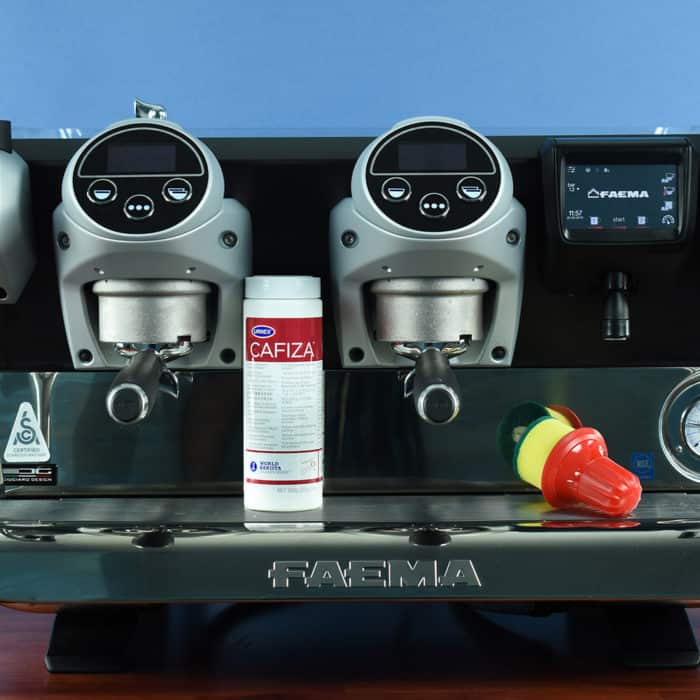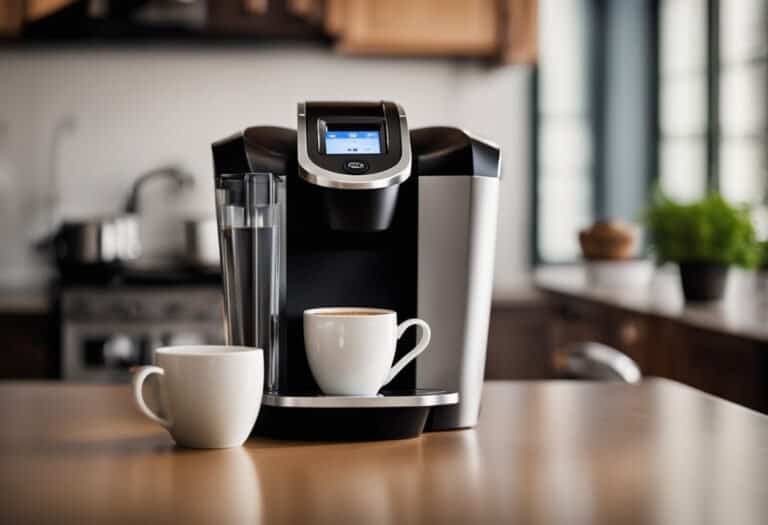How to Clean Your DeLonghi Espresso Machine: A Step-by-Step Guide

If you’re a coffee lover, you know how important it is to keep your espresso machine clean to ensure the best taste and quality of your coffee. The De’Longhi espresso machine is a popular choice among coffee enthusiasts because of its ease of use and functionality. However, like any other coffee machine, it requires regular cleaning and maintenance to keep it in top condition.
In this article, we will provide a step-by-step guide on how to clean your De’Longhi espresso machine. We will cover the essential parts of the machine that need to be cleaned regularly, including the group head, portafilter, steam wand, water tank, and drip tray. We will also discuss the materials you need and some tips to help you maintain your machine in between cleanings.
Whether you’re a beginner or an experienced barista, cleaning your De’Longhi espresso machine is a simple process that can be done in a few easy steps. By following our guide, you can ensure that your machine stays in top condition and produces delicious, high-quality coffee every time you use it.
Why Clean Your DeLonghi Espresso Machine
Regular cleaning of your DeLonghi espresso machine is essential to ensure that you continue to enjoy high-quality coffee with every brew. Over time, oils from coffee beans can accumulate in the machine, leading to clogs, a bitter taste, and even damage to the machine. Cleaning your DeLonghi espresso machine regularly will help to prevent these issues and extend the life of your machine.
In addition to maintaining the taste and quality of your coffee, cleaning your DeLonghi espresso machine can also help to keep it running smoothly. Regular cleaning can prevent clogs and blockages, which can cause your machine to malfunction or stop working altogether. By keeping your machine clean, you can ensure that it continues to function properly and produce delicious coffee.
Another benefit of cleaning your DeLonghi espresso machine is that it can help to improve the hygiene of your coffee-making process. Over time, bacteria can build up in the machine, which can be harmful to your health. By cleaning your machine regularly, you can help to prevent the growth of harmful bacteria and ensure that your coffee is safe to drink.

Materials Needed
Before we start cleaning our DeLonghi espresso machine, we need to gather a few materials. Here is a list of the items we’ll need:
- A clean cloth
- A non-abrasive cleaning solution (like a vinegar-water mixture)
- A tube brush for cleaning any gaskets or other hard-to-reach parts
- A container for collecting any parts you remove from the machine
- A small Phillips head screwdriver or allen wrench
- Paper towel or utility paper
- Nylon brush (a toothbrush works well)
- Micro-cloth
- Distilled water
- Fresh coffee beans
- An old toothbrush
It’s important to note that using the wrong materials can damage your machine, so make sure to use only the items listed above. Also, be sure to read the manufacturer’s instructions for cleaning your specific model of DeLonghi espresso machine.
Now that we have all of our materials, we can move on to the next step in the cleaning process.
Cleaning the Exterior
Keeping the exterior of your De’Longhi Espresso Machine clean is just as important as cleaning the interior components. A clean machine not only looks better, but it can also prevent the buildup of bacteria and other harmful substances. In this section, we will cover two important steps to clean the exterior of your machine: wiping down the machine and cleaning the drip tray.
Wiping Down the Machine
Before you begin wiping down your machine, make sure it is unplugged and has cooled down. Use a soft, damp cloth to wipe down the exterior of the machine, paying special attention to areas that are prone to buildup, such as the steam wand and the drip tray. Avoid using abrasive cleaners or scrubbers, as they can scratch the surface of the machine. For tough stains, use a mixture of water and mild dish soap, and be sure to rinse the area thoroughly with a clean, damp cloth.
Cleaning the Drip Tray
The drip tray is an important component of your machine that collects excess water and coffee grounds. It is important to clean the drip tray regularly to prevent the buildup of bacteria and other harmful substances. To clean the drip tray, remove it from the machine and discard any liquid or grounds. Use a soft, damp cloth to wipe down the tray, paying special attention to any nooks and crannies. If the tray is particularly dirty, you can soak it in warm, soapy water for a few minutes before wiping it down. Be sure to rinse the tray thoroughly with clean water and dry it with a clean towel before replacing it in the machine.
Cleaning the Interior
When it comes to cleaning the interior of your DeLonghi espresso machine, there are a few key areas that require attention. In this section, we will cover how to clean the filter baskets, brew head, and steam wand.
Cleaning the Filter Baskets
The filter baskets are an essential component of your espresso machine, responsible for holding the coffee grounds during the brewing process. Over time, these baskets can become clogged with coffee oils, which can impact the flavor of your espresso. To clean the filter baskets, follow these steps:
- Remove the filter baskets from the portafilter.
- Soak the baskets in a solution of hot water and a mild detergent for 10-15 minutes.
- Scrub the baskets with a soft-bristled brush to remove any remaining coffee oils.
- Rinse the baskets thoroughly with hot water.
Cleaning the Brew Head
The brew head is another critical component of your espresso machine, responsible for delivering hot water to the coffee grounds. Over time, the brew head can become clogged with coffee oils and other debris, which can impact the quality of your espresso. To clean the brew head, follow these steps:
- Remove the portafilter from the machine.
- Use a soft-bristled brush to clean the underside of the brew head.
- Rinse the brew head thoroughly with hot water.
- Replace the portafilter.
Cleaning the Steam Wand
The steam wand is responsible for creating the steam that heats and froths your milk. Over time, the steam wand can become clogged with milk residue, which can impact the quality of your frothed milk. To clean the steam wand, follow these steps:
- Fill a small container with hot water.
- Purge the steam wand by turning it on for a few seconds, allowing any built-up steam to escape.
- Place the steam wand into the hot water and turn it on for a few seconds.
- Use a soft-bristled brush to clean the steam wand thoroughly.
- Purge the steam wand again to remove any remaining water.
Descaling Your DeLonghi Espresso Machine
Why Descale Your Machine
Descaling your DeLonghi espresso machine is an essential part of its maintenance. Over time, mineral deposits from water build up inside the machine, which can affect the taste of your coffee and even damage your machine. Descaling helps remove these mineral deposits and ensures your machine continues to function properly.
Materials Needed
To descale your DeLonghi espresso machine, you will need:
- DeLonghi descaling solution
- Water
- A container to hold the descaling solution and water mixture
- A cloth for cleaning
Descaling Process
Before you begin, make sure your machine is turned off and unplugged.
Next, follow these steps:
- Prepare the descaling solution according to the instructions on the package.
- Fill the water tank with the descaling solution and water mixture.
- Place a container under the steam wand to catch any liquid that comes out.
- Turn on your machine and let the solution run through the machine until the water tank is empty.
- Refill the water tank with clean water and run it through the machine to rinse out any remaining descaling solution.
- Repeat the rinsing process until the water tank is empty.
- Wipe down the exterior of the machine with a damp cloth.
After descaling, your machine should be ready to use again. It’s recommended to descale your DeLonghi espresso machine every 2-3 months, depending on your usage and the hardness of your water.
Final Thoughts
We hope this guide has been helpful in teaching you how to properly clean your DeLonghi espresso machine. Remember, regular cleaning is essential to maintaining the quality and longevity of your machine.
It is important to note that while vinegar and citric acid are effective cleaning agents, they can also damage the internal components of your machine if used too frequently or in high concentrations. Be sure to follow the manufacturer’s instructions and use cleaning agents in moderation.
Conclusion
Cleaning your De’Longhi espresso machine is an essential task to maintain its optimal performance and ensure delicious coffee every time. Here’s a step-by-step guide on how to clean your De’Longhi espresso machine effectively.
To start, make sure to gather all the necessary cleaning supplies. You will need a clean cloth, a small brush, a mild dish detergent, and a descaling solution specifically designed for espresso machines.
First, unplug the machine and allow it to cool down completely. Once cooled, remove the water reservoir and empty any remaining water. Rinse the reservoir thoroughly with warm water and a few drops of dish detergent. Scrub the reservoir gently using the brush to remove any stubborn residue. Rinse it again with clean water and set it aside to dry.
Next, detach the portafilter and thoroughly clean it. Use the brush to remove any coffee grounds stuck in the basket and rinse it under warm water. If the basket is heavily soiled, soak it in a mixture of warm water and dish detergent for a few minutes before scrubbing it clean.
Now, it’s time to clean the exterior of the machine. Dampen the cloth with a mild dish detergent solution and wipe down the surfaces, removing any coffee stains or fingerprints. Be gentle when cleaning the control panel to avoid damaging any buttons or displays.
Moving on to the internal parts, check your machine’s user manual to locate the brew head and the group head screen. Remove the screen and clean it under running water, ensuring all the tiny holes are clear of clogs. Wipe the brew head and group head with a clean cloth to remove any residue or coffee oils.
To descale your De’Longhi espresso machine, follow the instructions on the descaling solution packaging. Generally, you will need to mix the descaling solution with water and fill the water reservoir. Then, run a descaling cycle as per your machine’s instructions. This process helps remove mineral build-up and ensures optimal water flow and temperature.
After descaling, run a few cycles of clean water through the machine to rinse out any remaining descaling solution. This step is crucial to prevent any residue from affecting the taste of your coffee.
Lastly, reassemble all the parts you’ve cleaned, including the water reservoir, portafilter, and group head screen. Plug in your De’Longhi espresso machine and let it warm up before brewing your next delicious cup of coffee.
Regularly cleaning your De’Longhi espresso machine will extend its lifespan and maintain its performance. Aim to clean it thoroughly once a month, or more often if you use it frequently. By following these simple cleaning steps, you can enjoy great-tasting coffee from your De’Longhi espresso machine every day.
Additionally, always use fresh, high-quality coffee beans and filtered water to ensure the best possible taste and performance from your machine.
Thank you for reading, and happy brewing!
RECOMMENDED READS
Top Rated Espresso Machines: Your Guide to the Best Options
How to Make Delicious Espresso Without a Machine: A Step-by-Step Guide
Mocha Magic: Tips for Crafting the Perfect Cup with Your Espresso Machine





